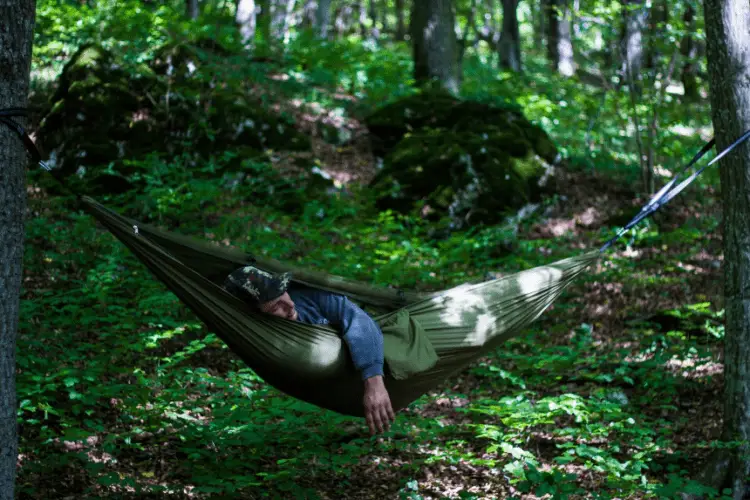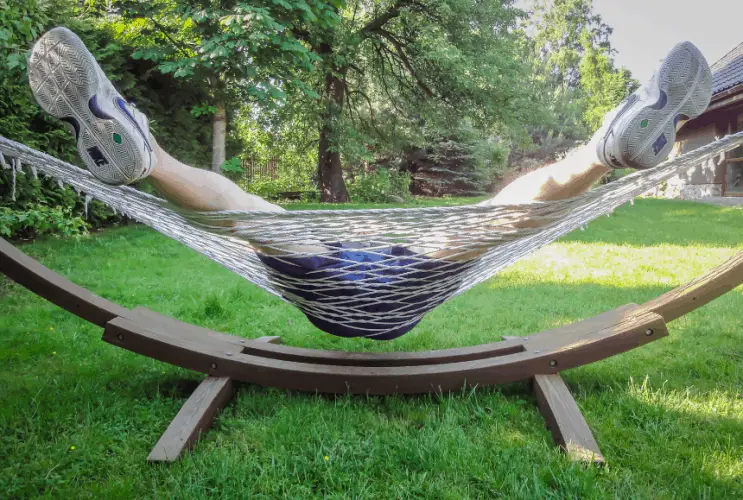How To Measure A Hammock: The Only Guide You Need [2021]
Hammocks used to be mainly a place to chill out drinking margaritas at a tropical resort. But over the last few years this has changed.
People are using them instead of tents when camping, rigging them in their backyard and setting up portable versions in the park on a nice day to read a book.
There are now countless hammock options available. From the classic woven rope hammock, to ultralight polyester fabric versions with built in bug nets.
As with most things these days, we have unlimited choices, but along with that comes unlimited confusion decided what is the right option for you.
Not only do you have to figure out what type of hammock you want, but you also need to get the right size. We will cover how to measure a hammock, hammock suspension, and why it matters.
Stick around. I promise you will find all the information super useful.
How To Measure Hammock Length?
To measure the length of a hammock you want to lay it flat and measure the length of the actual hammock, not including any suspension straps or rope.
When measuring include the loops you would attach the suspension or hammock stand to. When shopping for a hammock online, you can usually get this length measurement from the supplied specifications from the company.
Why knowing hammock length is so important?
Contrary to images you might see, the correct way to lay in a hammock is on a diagonal. You accomplish this by having the hammock hung with a relatively deep sag so it looks like a big smile.
If a hammock is too tight, it will force you to lie lengthwise, which becomes uncomfortable due to pressure on the shoulders and the back. Not good.
You need to know how long a hammock is to know how much usable space you will have. Since a hammock needs to be hung with sag (i.e., not stretched tight), it is important to know how much length you are dealing with.
If you have a hammock that is too short, it will be small to hang out in comfortably. Like a boss.
The importance of hammock width
Hammocks have two dimensions, so having one that is long enough but too narrow will still end up with an uncomfortable hang.
As we've said before, the most comfortable way to lie in a hammock is on a diagonal, so you need enough combined space that your feet or head won't be hanging off.
With a gathered-end hammock, which is the most common type of fabric hammock, the longer they are, the wider they are.
The goal is to have enough usable space when you are laying on about a 30-degree angle to have support from head to feet with nothing hanging over or any pressure points from tight fabric.
What’s the ideal length of a hammock?
When trying to figure out the ideal length of hammock, you need to look at a few factors. Wanna know more? Continue reading.
Your height
If you are over 6 feet, then you are definitely a big guy (or a gal). In that case you want a minimum length of 11 feet. This will give you enough room to lie diagonally without your feet hanging over.
How long you will lie in it
Just like with a bed, too big isn't an issue. Too small is. If you are going to sleep in a hammock when camping rather than in a mesh tent, then get an 11 foot or longer hammock to guarantee enough space to be able to lay flat.
Do you need room to share with someone else?
If you aren't just going solo but with your date, for example, then you want at least an 11.5-foot hammock with a weight rating enough for two people (or even more).
The extra length and width will give you the room to be cozy without being squished together to much.
If you are just going for a relaxing chill out session, then you can try sitting in the hammock like it is a couch with your feet hanging out.
What are the standard hammock sizes?
Depending on style, you can find hammocks that range from 7 to 12 feet. For adults, we recommend 10-12 feet for optimal comfort, especially if you plan to sleep in it for more than a little nap.
The bigger ones are good for hiking and backpacking purposes.
How to measure hammock structural ridge line
One way to add functionality to your hammock and make it easier to get the right amount of sag is to add a structural ridge line.
This is a fixed line of strong, low stretch cord that connects one end of your hammock to the other. When you suspend your hammock, it will pull tight on the ridgeline and won’t allow you to make the hammock too tight.
Additionally, the ridge line gives you a place to hang your gear, something to grab when getting out of the hammock. Plus, if you have a bug net, it will keep it off your face.
For the ridgeline, you want a cord that is low stretch and strong enough to support the tension of your weight.
I use a 5 mm spectra cord that is used for rock climbing anchors. It is super strong with a breaking strength of 4700 lbs. You can buy it from rock climbing stores or online.
To figure the right length of ridge line, you want to multiply the length of your hammock by 82%. So, an 11-foot hammock would need a ridge line that is about 108 inches. I tie mine on with a bowline knot, as it is compact and easy to untie after it has been weighted.
Understanding hammock suspension
When looking at portable hammock suspension, there are a number of systems available. Each has pros and cons.
Daisy chain straps
These have loops on each end with multiple sewn loops over most of their length. To adjust the length, you clip a carabiner to the next higher or lower loop.
They are very simple to use but each loop is about 4-5 inches apart so they lack the ability to do fine-tuned adjustments.
Whoopie slings
This type of suspension is made up of two parts: the tree strap and the adjustable cord. The cord is woven through itself so to adjust you slide it up or down and it locks in place when weighted.
This is the lightest type of suspension, which can be great for backpackers but can be trickier to adjust.
Cinch straps
Cinch straps are similar to whoopie slings in that they are micro adjustable. They accomplish this with a strap that goes through a self-tightening metal buckle.
Place the strap around the tree and back through itself and clip the other end to the hammock.
You then adjust by sliding the strap through the buckle like the straps you would use to cinch a load down on your roof rack. Heavier than whoopie slings, but lighter than daisy chain straps and very easy to adjust.
Rope
You can always tie up a hammock with rope, but you will want to have a way of padding the tree as bare rope can damage the tree.
With this it comes down to you knowing how to tie knots that will support your weight but be easy to untie.
Make sure you use a static rope with low stretch, otherwise you may have your butt on the ground when you get in the hammock. Check that the rope is rated to support many times over your body weight for safety.
Don’t overlook the spreader bars
When you have to suspend a hammock with less sag than recommended due to space issues, you can avoid some discomfort by using spreader bars.
This metal tube will go in the hammock sideways. That will keep the hammock open. They don't work with all hammocks, but if the company who makes the hammock offers a spreader bar, then it may be an option for you.
Another use of spreader bars is if you have two hammocks beside each other on the same anchor point.
When mounted this way, the two hammocks will be pressed into each other so the spreader bar is used to hold the hammocks spaced apart.
ENO makes ones that are great to put two hammocks under one tarp when you are hammock camping with significant other.
How hammock construction affects usable space?
Look for a hammock made from one piece of fabric as seams create tight ridges that can be uncomfortable to lie on.
When companies make hammocks with multiple panels, they usually sew them lengthwise. Therefore, when you are laying diagonally, you will be across these seams. That also makes the fabric towards the side of the hammock have less tension than the middle panel. This leads to the side panels being floppy and almost unusable.
Hammocks made with one piece of fabric spread the load over the whole hammock and let you use all the space much more comfortably.
There are also a number of uniquely designed hammocks that might use a frame or multiple suspension points (more than 2) to create the space you can lie in.
For these follow the manufacturer’s directions, as they function differently than traditional hammocks.
How far apart should trees or posts be for a hammock?
When looking or making a spot to hang your hammock, you need to get the spacing right. Since the suspension is usually adjustable, you have a range of distances that will work.
While you can push the limits a bit in either direction as a distance of 16-22 feet between anchor points is a good working range. If you are using an 11-foot-long hammock, going much shorter than that will have too much sag.
Going much longer will mean you run out of suspension length. Additionally, the further apart your uprights, the higher you will need to anchor the suspension to keep the hammock off the ground when you get into it.
How to hang a hammock for maximum comfort?
The biggest mistake people make when setting up a hammock is stretching it too tight. Having a good amount of sag will allow you to angle yourself in the hammock for a flat lay.
The steps to setting up a hammock are pretty straightforward but can vary a bit depending on what type of suspension system you use.
- Place suspension straps around the tree and girth hitch it to itself. Most straps have sewn loops that will allow you to feed one end through itself and you attach the hammock to the other end. Generally, you will want to place the straps around the tree between 6-7 feet off the ground.
- Attach the ends of the hammock to each end of the suspension straps around the tree
- Adjust the tension on the suspension until the unweighted suspension lines from hammock to tree are at a 30-degree angle.
- Adjust the height of the straps around the trees until the middle of the hammock is at mid-thigh height. This will then put it at chair height when weighted, making it easier to get in and out of.
- Sit in the hammock to test the height and seat the suspension. Lay in the hammock to test the comfort.
- You may have to readjust everything if it settled too low when weighted.
Little-Known Tips On Hanging A Hammock
I’ve been sleeping in hammocks for decades.
Here’s what I learned.
- If you are going to sleep in the hammock, then try putting the foot end slightly higher than the head end. Try 6 inches to start. This can help keep you from sliding down in the hammock as your upper body is heavier than your legs.
- If you are using trees, then use webbing straps rather than rope to wrap around the tree. Rope can bite into the bark deep enough to damage or kill the tree.
- When choosing trees to hang your hammock make sure they are alive. Look for leaves or needles. If a tree is missing a lot of bark or otherwise seems compromised, choose another option.
- You want to choose trees that are at least 8 inches in diameter. If you hike in a forested area, that won’t be a problem. The thicker the tree, the more of your suspension length it uses. Keep that in mind when looking at the distance between trees.
- Check the surrounding area for dead trees or branches overhead that could fall on your hammock. While not common, people have been killed because they set camp up in a fall zone of a dead tree.
- Before weighting your hammock, the suspension lines should be at around a 30-degree angle. To test this, make a finger gun with your index finger and your thumb. The line between the end of your index finger and your thumb will be around 30 degrees. Our eye is good at judging level so just make sure your index finger is level and use this to judge if your suspension lines are around the right angle.
- Since you are aiming for a 30-degree angle, the further apart your trees are, the higher your suspension straps need to be so your hammock doesn't hit the ground when weighted.
- Once the strap is loosely around the tree, you can use a stick to push it higher before pulling the strap tight to hold it in place.
Conclusion
A hammock is awesome for both relaxing and sleeping in as long as it is sized appropriately and hung correctly.
Using our information and tips, you should now be able to size a hammock much more accurately and find the right option for your needs. Now you just need to get outside and go for a hang.
Winston Endall
Having worked in the outdoor, fitness, and cycling industry his whole life, Winston brings a wealth of real world knowledge on the topics. Rock climbing, backpacking, cycling and wilderness survival are his life. As both an athlete, coach and outdoor educator, his practical experience translates into his writing to help people better pursue their outdoor passions.. Read more about Winston here.

![How To Measure A Hammock: The Only Guide You Need [2021] how to measure a hammock](https://gearuphiking.com/wp-content/uploads/2021/02/how-to-measure-a-hammock.png)








